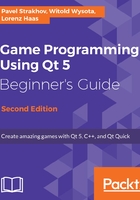
上QQ阅读APP看书,第一时间看更新
Origin point of the transformation
In our next example, we will create a cross at (0, 0) point and add a rectangle to the scene:

You can do it with the following code:
scene.addLine(-100, 0, 100, 0); scene.addLine(0, -100, 0, 100); QGraphicsRectItem* rectItem = scene.addRect(50, 50, 50, 50);
In this code, we use the addLine() and addRect() convenience functions. This is the same as creating a QGraphicsLineItem or QGraphicsRectItem and adding it to the scene manually.
Now, imagine that you want to rotate the rectangle by 45 degrees to produce the following result:

A straightforward attempt to do it will use the setRotation() method:
QGraphicsRectItem* rectItem = scene.addRect(50, 50, 50, 50); rectItem->setRotation(45);
However, if you try to do that, you will get the following result:
